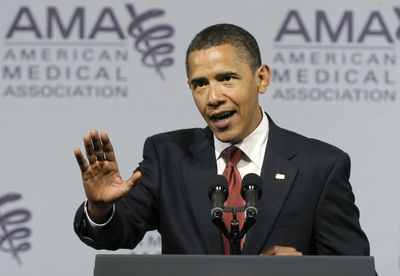Reform may hinge on primary-care doctors
Shortage of physicians could become more severe

WASHINGTON – As the debate on overhauling the nation’s health care system exploded into partisan squabbling, virtually everyone still agreed on one point: There are not enough primary-care doctors to meet current needs, and providing health insurance to 46 million more people would threaten to overwhelm the system.
Fixing the problem will require fundamental changes in medical education and compensation to lure more doctors into primary-care offices, which already receive 215 million visits each year.
The American Academy of Family Physicians predicts that, if current trends continue, the shortage of family doctors will reach 40,000 in a little more than 10 years, as medical schools send about half the needed number of graduates into primary medicine.
The overall shortage of doctors may grow to 124,400 by 2025, according to a study by the Association of American Medical Colleges. And, the report warns, “if the nation moves rapidly towards universal health coverage,” the shortages “may be even more severe.”
Many of the measures needed to compensate for shortages – such as easing the debt incurred by medical students and expanding the role of community health centers – are included in the provisions being put forth by lawmakers, but there is no quick or easy fix within the grasp of Congress or the Obama administration.
“You’re talking about an eight-to-12-year period to fix the problem,” said Robert L. Phillips Jr., director of the Robert Graham Center for Policy Studies in Family Medicine and Primary Care, part of the American Academy of Family Physicians.
Evidence that demand already exceeds the supply of primary-care doctors ripples through the system as patients increasingly have trouble finding a new doctor, then wait weeks or months for an appointment, spend more time in the waiting room than in the examining room, encounter physicians who refuse to take any form of insurance, and discover emergency rooms packed with sick people who cannot find a doctor anywhere else.
Fifty years ago, half of the nation’s doctors practiced what has come to be known as primary care. Today, almost 70 percent of doctors work in higher-paid specialties, driven in part by medical school debts that can reach $200,000.
“We need to rethink the cost of medical education and do more to reward medical students who choose a career as a primary-care physician,” President Barack Obama said in a speech to the American Medical Association on Monday.
The disparity results from Medicare-driven compensation that pays more to doctors who do procedures than to those who diagnose illness and dispense prescriptions. In 2005, for example, Medicare paid $89.64 for a half-hour visit to a primary-care doctor in Chicago, according to a Government Accountability Office report. It paid $422.90 to a gastroenterologist who spent about the same amount of time performing a colonoscopy in a private office. The colonoscopy, specialists point out, requires more equipment, specialized skills and higher malpractice premiums.
In the various legislative proposals under debate, Congress and the administration have moved toward providing incentives for doctors entering residency programs to pursue careers in primary care. Most residency slots are funded through Medicare, giving the government a stick to wield over residency administrators, and changes in Medicare reimbursement alluded to by Obama on Monday could be the carrot that makes primary care more attractive.
Obama also wants to expand the National Health Service Corps, which helps medical students pay tuition in return for two to four years of service in communities that do not have enough doctors.
Community health centers would be expanded under all of the major proposals. And the measures envision far greater use of nurse practitioners and physician assistants, who would be teamed with doctors in larger groups.